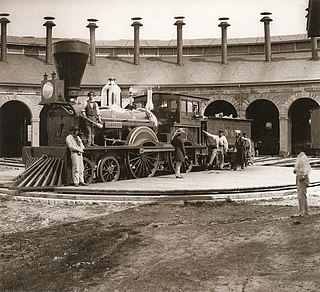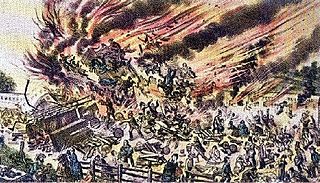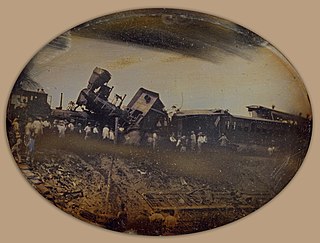Related Research Articles

The Great Western Railway was a railway that operated in Canada West, today's province of Ontario, Canada. It was the first railway chartered in the province, receiving its original charter as the London and Gore Railroad on March 6, 1834, before receiving its final name when it was rechartered in 1845.
On February 8, 1986, twenty-three people were killed in a collision between a Canadian National Railway freight train and a Via Rail passenger train called the Super Continental, including the engine crews of both trains. It was the deadliest rail disaster in Canada since the Dugald accident of 1947, which had thirty-one fatalities, and was not surpassed until the Lac-Mégantic rail disaster in 2013, which resulted in 47 deaths.
The Central Massachusetts Railroad was a railroad in Massachusetts. The eastern terminus of the line was at North Cambridge Junction where it split off from the Middlesex Central Branch of the Boston and Lowell Railroad in North Cambridge and through which it had access to North Station in Boston. From there, the route ran 98.77 miles west through the modern-day towns of Belmont, Waltham, Weston, Wayland, Sudbury, Hudson, Bolton, Berlin, Clinton, West Boylston, Holden, Rutland, Oakham, Barre, New Braintree, Hardwick, Ware, Palmer, Belchertown, Amherst, and Hadley to its western terminal junction at N. O. Tower in Northampton with the Connecticut River Railroad.

The Great Train Wreck of 1856 occurred in Whitemarsh Township, Pennsylvania, between Camp Hill station and Fort Washington station, on July 17, 1856. Two trains, traveling on the same track in converging directions, collided, killing between 59 and 67, and injuring over 100. The incident was referred to as The Camp Hill Disaster in Montgomery County, and The Picnic Train Tragedy in Philadelphia. It was the deadliest railroad catastrophe in the world up to that time and became one of the signature events of its era.

The 2008 Chatsworth train collision occurred at 4:22:23 p.m. PDT on September 12, 2008, when a Union Pacific Railroad freight train and a Metrolink commuter rail passenger train collided head-on in the Chatsworth neighborhood of Los Angeles, California, United States.
The Jeannette's Creek train wreck, also known as the Baptiste Creek train wreck, was a fatal railroad accident on October 27, 1854, at Baptiste Creek near present-day Jeannettes Creek in Chatham-Kent, Ontario. It was Canada's first major train wreck, leaving 52 people dead and indeed the worst rail disaster in North America at that time.

On August 12, 1853, two Providence and Worcester Railroad passenger trains collided head-on in Valley Falls, Rhode Island. The accident resulted in 14 fatalities and a further 17 serious injuries, an unknown number of passengers suffered less severe injuries.

On the night of Wednesday, June 21, 1905, the New York Central Railroad's flagship passenger train, the 20th Century Limited, derailed in Mentor, Ohio, on the Lake Shore and Michigan Southern Railway line, killing 21 passengers and injuring more than 25 others on board. A switch from the mainline to a freight siding was open, causing the Limited to leave the mainline and overrun the siding at high speed. The cause of the accident was never officially determined, but overwhelming evidence points to an act of rail sabotage. The 20th Century Limited connected New York City to Chicago; its running time had just weeks earlier been reduced from 20 hours to 18.
The 1958 Sterlington railroad disaster was a head-on collision by two Erie Railroad trains on August 11, 1958 at 6:47 AM killing 5 people and injuring 22 to 36. The collision occurred when the operator in the signal tower at Suffern failed to hold the westbound train No. 53 at Suffern for the eastbound No. 50 commuter train from Monroe, New York, to Hoboken, New Jersey. When he realized his error, he attempted to contact the crews via radio but was unsuccessful due to a radio dead spot. The trains impacted head-on right in front of the now abandoned Erie Railroad depot in Sterlington, New York near Sloatsburg, killing the crew of the locomotive No. 859 from train No.50 as well as two passengers and injuring the crew of the locomotive No. 1402 from the westbound train.

The Baker Bridge train wreck occurred on November 26, 1905, in Lincoln, Massachusetts, when two passenger trains on the Fitchburg line of the Boston and Maine Railroad were involved in a rear-end collision. Seventeen people were killed in the wreck. Engineer Horace W. Lyons was charged with manslaughter; however, a grand jury chose not to indict him.
In 1890 a railway accident in Quincy, Massachusetts killed 23 people. It was the second major train wreck in the city, following the 1878 accident in Wollaston. The accident was caused by a jack that had been left on the track. The foreman of the crew that placed the jack on the track was charged with manslaughter, but the trial ended in a hung jury.
References
- 1 2 3 "Terrific Railroad Crash; An Excursion Train Wrecked Near Boston" . The New York Times. October 9, 1878.
- 1 2 "Terrible Railway Disaster: Excursion Train on Old Colony Railroad thrown from Track". The New England Farmer, and Horticultural Register. October 12, 1878.
- 1 2 3 4 5 6 Annual Report of the Board of Railroad Commissioners. Vol. 10. Boston. 1879. pp. 37–49.
{{cite book}}: CS1 maint: location missing publisher (link) - 1 2 3 "The Wollaston Disaster; Responsibility For The Loss Of Life" . The New York Times. October 10, 1878.
- ↑ "DESOLATION.: Heartrending Story. Terrible Accident at Wollaston". The Boston Daily Globe. October 9, 1878.
- ↑ Annual Report of the Board of Railroad Commissioners. Vol. 11. Boston. 1880. pp. 186–187.
{{cite book}}: CS1 maint: location missing publisher (link) - ↑ "Conductor Hartwell Arrested for Manslaughter". The Boston Daily Globe. October 12, 1878.
- ↑ "The Wollaston Disaster". The New York Times. October 13, 1878.
- ↑ "Wollaston: The Official Investigation Begun". The Boston Daily Globe. October 17, 1878.
- ↑ "The Wollaston Disaster; Plea Upon Which Conductor Hartwell's Discharge Is Asked Theory Of The Defense" . The New York Times. October 18, 1878.
- ↑ "The Wollaston Verdict: Hartwell Found Guilty of Gross Negligence--Engineers Westgate and Hurlburt Censured". The Boston Daily Globe. October 26, 1878.
- ↑ "The Wollaston Disaster: Charles H. Hartwell Arraigned for Manslaughter". The Boston Daily Globe. April 23, 1879.
- ↑ "Hartwell Found Guilty; The Responsibility For The Wollaston Disaster Placed On The Conductor". The New York Times. April 25, 1879.
- ↑ "Legal Department: Manslaughter—Liability of Conductor". The Boston Traveller. March 13, 1880 [February 28, 1880] – via Railway World.; "The Case of the Old Colony Conductor" . The Boston Traveller. March 1, 1880 [February 28, 1880] – via The New York Times.